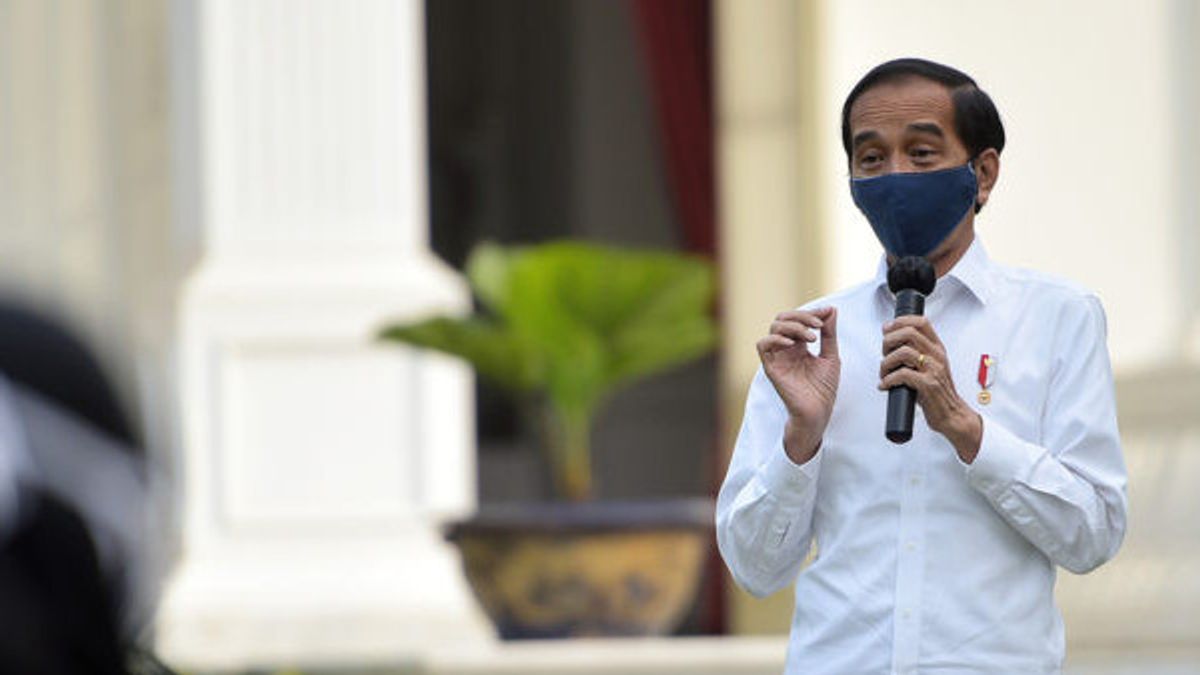JAKARTA - The administrations of President Joko Widodo (Jokowi) and Vice President Ma'ruf Amin are even one year old. Various unexpected obstacles must be faced, one of which is the COVID-19 pandemic.
As a result of this outbreak, a number of countries collapsed, their economic growth slumped due to pressure from COVID-19. The Indonesian economy was also affected, although superficially.
In the second quarter of 2020, Indonesia's economic growth contracted by 5.3 percent. Even so, the government claims, the contraction experienced by Indonesia in the second quarter was much better than other Southeast Asian countries, even among the G-20 countries.
Economically, Indonesia is ranked third behind China and South Korea.
Apart from having an impact on economic contraction, the COVID-19 pandemic also affected 3.5 million workers who were laid off or laid off. In fact, the unemployment rate rose to 10.4 million people. The poverty rate also increased to 26.42 million people, especially in urban areas.
Because of this condition, the government immediately looked for a cure. One of them is by adapting balance sheet governance.
This adaptive financial governance is considered to have a positive impact. With foreign exchange reserves of 135.15 billion US dollars as of September 2020, it is able to finance imports and pay off government foreign debt for 9.1 months.
This time span is more than three times above international standards. In addition, foreign exchange reserves as of September 2020 were also higher than 2019, which amounted to 129.18 billion US dollars.
In Jokowi-Ma'ruf's one-year report, the government is asked to remain vigilant of its foreign exchange reserves. Including preparing the potential in the tourism sector. This is because the number of tourist arrivals in the January to August 2020 period has dropped sharply.
"The government must remain vigilant of its foreign exchange reserves by preparing the potential in the tourism sector," he was quoted as saying in the 'Jokowi-Ma'ruf 2020 Annual Report' published on ksp.go.id, Tuesday, October 20.
Based on data from the Central Statistics Agency (BPS), tourist visits to Indonesia in 2015 cumulatively reached 10.2 million. Then, in 2016 it has increased to reach 11.5 million. Then, in 2017, it was 14 million. In 2018, the number of tourist visits reached 15.8 million. While in 2019 it reached the highest peak of tourist visits, namely 16.1 million.
However, in 2020 in the January to August period, tourist visits only reached 3.4 million. Compared to the same period last year this figure decreased by 7.3 million. Where as many as 10.7 million tourists made tourist visits in the January to August period in 2019.
Not discouraged, Jokowi-Ma'ruf believes the country's tourism industry can recover. Indonesia is considered to have quite a large potential for tourism destinations, especially with five super priority National Tourism Strategic Area (KSPN) destinations, namely Lake Toba, Borobudur, Mandalika, Labuan Bajo, and Manado-Bitung-Likupang.
On the other hand, a government debt ratio of less than 35 percent of the Gross Domestic Product (GDP) indicates prudent debt management. This debt rating also shows that Indonesia is still feasible as an investment destination.
[/ read_more]
The government has also seen signs of improvement in future economic conditions from improvements in the Purchasing Manager Index (PMI) in manufacturing and the Consumer Confidence Index.
As for the details, namely in January the position was at 49.34 points. Then, it rose in February to reach 51.88 points. Due to the COVID-19 pandemic outbreak in the country, the figure has again fallen to 45.33 points. In April, it fell again to 27.49 points.
However, improvements began to appear in May with a slight increase of 28.62 points. In June the figure rose sharply to 39.07 points. Then, July also saw an increase of 46.88 percent. In August it rose again to 50.76 points. However, in September, it decreased again, namely 47.20 points.
Meanwhile, the consumer confidence index fluctuates. In January it reached 121.67 points. Then, in February it fell to 117.65 points. Then, in March the figure was in the position of 113.78 points. However, in April there was a deep decline to the position of 84.83 points.
There was no improvement in May, the position was getting lower, namely 77.80 points. However, in June there was a slight wear, namely 83.78 points. Then it consistently rose in July and August, namely 86.19 points and 86.90 points. However, in September it fell again to 83.40 points.
Assistance for MSMEsThe government also pays great attention to small and medium enterprises (MSMEs) to survive the crisis. A number of incentives are also aimed at MSMEs in the context of poverty alleviation, economic equality, and job creation. The Jokowi-Ma'ruf government has allocated IDR 4.2 trillion for the UMKM Go Digital program.
According to data from the Ministry of Cooperatives and SMEs as of September 15, 2020, 1.6 million UKM and IKM units have gone digital out of the total target of 2 million SME and IKM units.
Other assistance was provided in the form of People's Business Credit (KUR) worth IDR107.28 trillion to 3,172,616 debtors. Then the Ultra Micro Credit (Umi) amounting to IDR 4.85 trillion to 1,499,953 debtors, and the Mekaar program with a total distribution of IDR 11.2 trillion to 6.57 million debtors.
A Job Creation Omnibus Law (UU) was also proposed, with the aim of creating a competitive investment climate and creating jobs. This regulation also provides convenience in licensing UMKM.
[/ read_more]
The English, Chinese, Japanese, Arabic, and French versions are automatically generated by the AI. So there may still be inaccuracies in translating, please always see Indonesian as our main language. (system supported by DigitalSiber.id)













